VOL. XVI NUMBER 1 ASSOCIATION NEWSLETTER MAY 2010
A veteran – whether active duty, retired, national guard or reserve – is someone who, at one point in his life, wrote a blank check made payable to “The United States of America,” for an amount of “up to and including my life.”
ODDS and ENDS
From time to time our people have approached members of our Board of Directors with suggestions that our Association make charitable donations supporting specific groups or scholarships or otherwise spend money outside the Association. Our Association is a 501c19. To comply with our tax exemption we can only use our funds for our reunions. The funds donated from the book Firebirds were also restricted for use at our reunions.
Please check the mailing label on this newsletter to see if dues are due. If the number to the right of your name says 2010, that means your dues expire on June 30th of this year. Our dues year runs from July 1st to June 30th. If you have never paid dues but like getting the newsletter, I suggest you send them to the Association this year before the address directory is mailed around July 1st. Dues are only twelve dollars per year or life memberships at age 60 and below – $150, age 61 to 65 – $125, and 66 and above – $100.
The lapel / hat pins which many of you have received at previous reunions were all donated to the past reunions by a member. This was never a part of Military Reunion Planners contract and should not have been expected to be. The bumper stickers you received at Nashville were from this same member in lieu of the pins. Please do not ask Military Reunion Planners to supply pins or anything else without talking to board members first. The Association could be charged for this material.
No decision whatsoever has been made about our 2012reunion site.
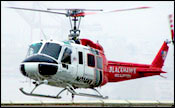
Tom Knapp had a story written on the USGA (United States Golf Association) website last Veteran’s day. Enter and click on this link to read this story: http://www.usga.org/news/2009/November/Honoring-Veterans–A-War-Story/
Jim Gibbs made a wonderful album of his photos from Vietnam with vivid descriptions. Shortly before the reunion, Gibbs and sent the Association 100 copies of this album on a DVD. These DVDs were given away during the reunion. Our thanks to Jim for doing this and for his hard work on the project.
2010 NASHVILLE REUNION

Our Nashville Reunion was another great success. The numbers in attendance bounced around as some could not attend and others surprised us. The actual count (we think) came to 176 members and 6 associate members in attendance. Total attendance would have approached 400 counting everyone.
While sitting at a table looking at some David Able photos, David remarked that there was no one at the reunion he knew. About two photos down I came upon a photo of Robert McCullough. It was the best photo David had. I told him, “This guy is here!”
Fred Biermann (EM 65) had attended this reunion for the first time. Fred awoke Thursday morning blind in his right eye due to a blood clot in the artery behind the eye. The retina was dead because of this and his eye will be removed. Prayers were offered for his situation by our Chaplin Eric Kilmer during our Memorial Service. We hope to see Fred and his wife Fran at our next reunion.
The flooding affected some tours but had no impact on hotel activities. The Thursday General Jackson tour, which was canceled due to the flood, was replaced by a tour to the Jack Daniels Distillery in Lynchburg.
The Thursday afternoon Women’s Meeting was led by two Nashville VA counselors, Dr. Lori A. Simms and Dr. Shari Harwell. The subject matter covered was PTSD and its effect on our lives. An article by Kay Seabolt in this newsletter expounds on this meeting.
The Friday morning Firebird Freefire Golf Outing was moved to a different site and played by 20 or so members.
At the Grand Ole Opry, held in the Two Rivers Baptist Church, our group was singled out twice for our service with a rousing ovation from the crowd. Four busloads were transported for this occasion, enjoying the Charlie Daniels Band along with several other great acts.
On Saturday morning, Armed Forces Day, our Memorial Service was conducted. This is done at every reunion, honoring our fallen brothers for their sacrifice. Fittingly it continues to be a key part of our reunions in which the fallen brother’s name is called and answered for him by hundreds of people saying, “Here Sir!”. Echo Taps was played with our senior ranking officer, Major General Tom Griffith (USAF, ret) ordering the hand salute. This was followed by the Lee Greenwood classic, “God Bless the USA”.
Before the service started Frank Anton gave a short talk concerning his time with us and his 5 years as a POW. It was mixed with humor and sincerity and enjoyed by all.
Our Association business meeting was held at which the Board of Directors election was held. James Malone (EM 71) was replaced by the election of Jim Surwillo (EM 69-70) because of term limitations. Malone had served four years and his time on the board was surely appreciated. The Board as it now stands is Ron Seabolt (EM 66-67) – National Director; Johnnie Hitt (OF 69-70) – Deputy National Director; Chuck Carlock (WO 67-68) – Secretary / Treasurer; Terry Igoe OF 68-69) – member at large; John Mateyko (WO 65-66) – member at large and Jim Surwillo (EM 69-70) – member at large.
A prepared statement was read by National Director Ron Seabolt informing the members of the criteria used in selection of reunion sites and the guarantees that must be met by the Association in order to receive concessions from hotels. This subject will be repeated in the last newsletter mailed before the next reunion as a reminder of commitments made by our Association.
A misstatement was made by a member in which he said that all money spent on our Association items for sale, membership dues and any other means by which you receive something of value in return are tax deductable and you could receive a receipt from the Association and then take this off your taxes. The tax deduction is only legal on money directly donated to the Association with no return of merchandise or membership expected. To claim any other as a deduction is illegal. It was also stated in the meeting that we were a 501[C] 3 while we are actually a 501[C]19 and the difference is the type of fund raising we can do. We can only raise money for our reunions.
A group photo was made following the meeting and appears in this letter.
A new segment was added to the reunion called “War Stories”. Jim Fulbrook had suggested this about a year ago as something that is done by the VHPA. As at all reunions, war stories are repeated among former flight crews and others, but the group as a whole never hears these tales. At the “War Stories” segment a person gets a chance to tell his story to a much wider audience. These stories are almost all humorous in nature. The time was well spent, enjoyed by all and will most likely become a fixture at future reunions.
A small tour visited “The Hermitage”, home of President Andrew Jackson, on Saturday.
Michael Durant arrived Saturday afternoon and as requested by our Association, sold autographed copies of his great book, In The Company of Heroes. The book was well received by our members with almost four cases sold.
Our cocktail hour at 6 pm was followed by the banquet. The colors were posted by a team of Firebirds and did their usual great job. The Pledge of Allegiance was led by our former POWs, Frank Anton and Jim Pfister. This was followed by the National Anthem as sung on a CD by Christy Phillips, daughter of deceased member Allie Campbell.
Dinner was served and enjoyed by all. At the closing minutes of the meal, the raffle drawing was held, conducted by Ron Seabolt and Vic Bandini. The actual drawing was made by Mi Windus, grandson of former Rattler “6” Lew Henderson. Six items were in the drawing with first winner having their choice until all six were selected. Lil Day won a set of round trip AirTrans Airlines tickets to anywhere in the US that they fly. Mike Chauncey won and selected a new tail rotor chain bracelet. Vinnie Harrington won and (with input from Mickie) chose a $200 Macy’s card. Richard Rodriguez won and chose another set of AirTrans Airline tickets. Archie Pitts’ granddaughters won and chose the personalized Joe Kline print. Mark Leopold won the mahogany Huey slick.
Our program began with Vic Bandini’s remarks and recognition of specific persons who are held in especially high esteem and others who help in duties that must be fulfilled in order to have a successful reunion.
The National Director Awards portion was led by Ron Seabolt who took the moment to relay his own story of how his luck throughout his military career (two years) placed him in the best helicopter company in Vietnam and to relay his thanks to all the people who make reunions successful. That being the people who support us by attending reunions and who made us the best of the best.
The Jesus Nut Award is presented to the person who travels the longest distance from their hometown to be at the reunion as calculated by the Association computer mileage calculator. This award was won by Bob Gardiner.
A new award had been created for this and future reunions named the “Unsung Hero Award” to honor our fine support personal. The award was actually the end of a chromed eight inch section of tail rotor drive shaft made into a goblet with the hanger bearing half as a handle. A quip was made that this winner was getting the “shaft”. The criteria for this award is: you had to be the best of the best, your primary duty in our unit was not as a flight crew member and you had to be in attendance at the reunion. Jerry Fairfield (EM 66-68) won this for his service in our unit which covered an 18 month span. Jerry was known for his efficiency and dedication to “always doing it right”.
Gary Fisher was introduced to conduct the “Rattler Legend Award”. Col. Kathleen Henderson (USMC ret.) was brought forth to be on stage as her dad, Col. Lewis Henderson, was presented this award. Major Lew Henderson had brought the company over from the United States and was the very first “Rattler 6”. All who knew him back then and know him now fully believe that this was a wonderful leader who richly deserved this honor.
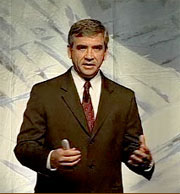 Michael Durant
Michael Durant
Our banquet guest speaker, Michael Durant, was introduced and gave us a great speech about his military career and the infamous Somalia action that led to his crash and capture. This gracious gentleman was the only survivor of “Super 64” in the Somalia engagement from which the book and movie Blackhawk Down became famous in the 90s. Mr. Durant suffered severe injuries in the crash of Super 64, the aircraft he was commanding and had little treatment after being captured. He was released after being held eleven days and completely recovered after being told he would never be the same. His unit motto was NSDQ which stands for Night Stalkers Don’t Quit, a motto taken seriously by him in his recovery.
The fact that two men, Gary Gordon and Randy Shughart, were both awarded the Medal of Honor posthumously for trying to aid and rescue Durant and his crew is testimony of the fact embodied in the Blackhawk unit motto, NSDQ. It was inspiring to hear this speech.
Michael Durant was nominated to be an honorary member of our Association. This nomination was seconded and passed by acclimation.
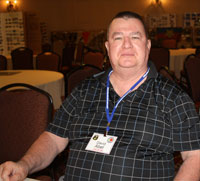
David-Abel-EM-65-66
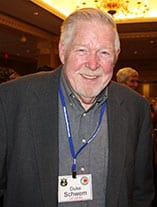
Duke Schwem OF 64-65

Fred Biermann EM 65
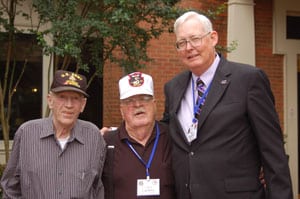
Jerry Tippitt (EM 67), Larry Lackey (EM 66-69) & Ron Seabolt (EM-66-67)
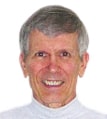
Jim Gibbs WO 67-68
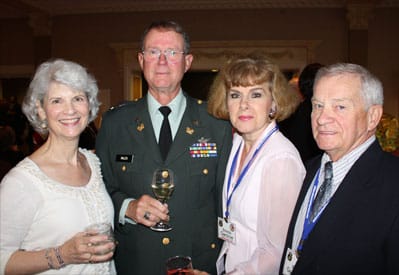
Marsha & Jim Malek (WO 67-68) and Brenda & Bob-Gardner (WO 68-69)

Michael Durant & Rattler 6 Bill Price (OF 69)
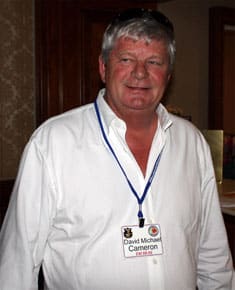
Mike Cameron EM 68-69
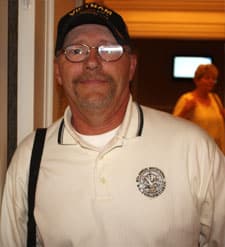
Mike Mietus EM 69-71
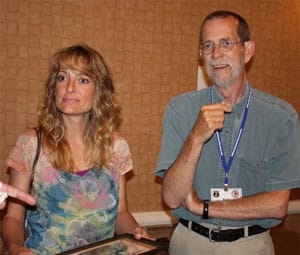
Pam & Ken Linville WO 65
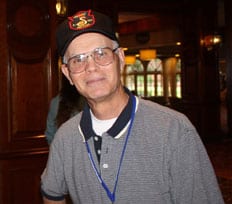
Philip Koonce (EM 65-66)

Rattler Legend Lew Henderson (OF 64-65) & Rob Eggleston (WO 65-66)
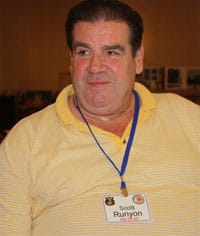
Scott Runyon EM 68-69
A PLEASANT SURPRISE FOR RATTLER 6
By Bill Price (OF 69)
Ron Seabolt made sure that I attended this year’s reunion in Nashville. After having retired from the Army in 1974 I had never looked back so the thought of gathering with soldiers I served with 41 years ago had no appeal to me. That was ancient history of another life.
But he persevered and I relented and agreed to come. Now I feel like I should have paid him to have invited me. What a great experience! And in a super location. First class and organized to the nth degree.
Before I go any fartherI want to say that I looked at the attendees and formed this opinion of what I saw. I saw those slim, energetic, hard charging warriors of 1969 clothed with an accumulation of life. But they are still in there only now better controlled by wisdom which comes from experience in life and raising families. I was proud to be in their company.
They all had good taste in wives who brightened the convention with their obvious pride in their special Rattler/Firebird partner. They must have changed a lot after they got home to get such fine, cultured ladies to be their wives. Yes, the Rattlers definitely married up from where I remembered.
I was pleased to meet the first Rattler “6”. Lew Henderson is still a “6” in my opinion and did you see those fine grandsons? How about his Marine Colonel daughter? She has great military bearing and presence and made me want to salute when I looked at her. And of course his Rattler “5” (Ramona) ought to be a Rattler “9” at least for being his backup all these years.
I was honored to find out that anyone even remembered me from back then. There was John May my crew chief and Short Round Roger Hobbs my replacement door gunner after Michael Deahl was hit on Black Monday.
Wife Betsy and I had the pleasure of dining at the banquet with my left wing man on Black Monday, Mike Curtis and wife Ellen.
Other than the caliber of those in attendance I was next most impressed by the organization and efficiency I witnessed in putting on the reunion. Things went off with military precision and I didn’t catch a single flaw. If Seabolt doesn’t want to take credit for a superb job at pulling together all the pieces then he’ll have to give it to someone else. Until he does I think it was him and Chuck Carlock.
Vic Bandini was smooth as silk behind the podium. Either he practices a lot or he has been polished somewhere for 41 years. He was slick in Chu Lai but now he is smooth.
Michael Durant was an excellent choice for banquet speaker. His story is compelling and we are fortunate that he survived and was able to tell us of the ruthless enemy we now face. I hope he sold a ton of books. I bought six for my boys and a couple of combat brothers at church.
Wife Betsy, being a second marriage, had never been in association with a group such as the Rattlers. I was able to gain a great deal of insight into what we saw and experienced from her. She had nothing but good to say about those she met. The camaraderie and esprit in evidence and the love and respect shown by those whose early character was formed by shared hardships and harrowing episodes of flight or rockets at night greatly touched both of us. Though I’m more hard hearted and don’t let it show.
Ron will not have to nag me into attending again. I will be there as long as it is in a gun friendly state. Nowadays one has to watch his six…and his three and his nine.
I want all the ‘69 Rattlers to know that I was honored to have been their “6” and that I was just an old Green Beret Sergeantwho went to OCS and Flight School and was put into that position by a Colonel that I had worked for before. As I recall only me and the XO of the company were on second tours so I felt it my duty and nature to lead from the front and to always run towards the sound of the guns.
And under my accumulation of life is still that slim, energetic, hard charging warrior of Chu Lai, summer of 1969.
VETERAN’S AFFAIRS
VA – Delay, deny, and hope that you die!
When the $200 Macy’s card was announced as a raffle prize, one member asked the question, “A $200 mason jar”. The bottom line is way too many of us cannot hear worth a flip. Most of this is related to our military experience. If you are pursuing a hearing disability or already have one and have copies of your hearing tests, we would like to have copies of them (without names). It is very difficult to know what the VA criteria for hearing loss is. If we can compare each others test and know what was awarded we can be better prepared to fight this battle.
If you are filing for Tinnitus (ear ringing) or hearing loss, asked follow Rattler, Firebird or maintenance personnel for a letter backing up what we endured daily. The high freq turbine engine and transmission noise plus the deafening gunfire.
A new fact about VA benefits was recently learned. It has to do with ED (erectile dysfunction). If you have diabetes, hypertension, prostate cancer or PTSD and also have ED and have it documented , you are eligible to draw a special monthly compensation of $98. It does not matter if you are drawing a 100% disability. This special comp is added to any amount of monthly disability you are drawing. If you have ED and have not mentioned it to your VA doctor, do so ASAP. This doctor is the person who has to put you in for the special compensation.
This $98 is a “K” rating. There are also L,M,N,O,P,Q and R special ratings in which the amount added to your disability can be as high as $7500 (not a misprint) a month. This info was obtained from one of our 100% PTSD guys and confirmed by this editor’s visit to his Disabled American Veteran’s service officer.
Subject: Check out USAA Military Home, Life & Auto Insurance Banking & Investing
USAA has opened membership to all Honorably DischargedVeterans. For many years,membership wasonly for Active Duty Officers and Cadets in the Military Academies.
A few years ago, it was opened to Active Duty NCO’S, and later all Active Duty Enlisted. Recently membership was made available to Reserves, and now ALL VETERANS. Proof of service is needed. DD214 or Honorable Discharge.
This is the premier Insurance, Banking and Investment Company in the US.USAA is owned by the Members; there are no stockholders.The onlyinsurance companyto consistently receive the highest ratings from Moody’s, Best, etc. for performance.
Substantial savings can be realized on all insurance products (Auto, Homeowners, Umbrella, Boat, Motorcycle)Banking, Credit Card,Financial and Bankingproducts. Over 95% of Officers and 80+% of enlisted eligible’s are members. This should be publicized to all of our American Legion,VFW, USIVO, Korean War, Marine Corps League, etc.,members. Suggest thatannouncementsbe made at the County and Post meetings or through a mailing to our members. Their websiteis www.usaa.com. For general information, prospective memberscan call 1-800-531-8111.
TAPS
The Association has been notified of the following deaths since our last newsletter:
- Thomas L. Cain (EM 68-69) died 12 May 2010 of Agent Orange caused cancer.
- John E. Cawley, Jr. (OF 66-67) died 20 December 2006 of unknown causes.
- Mark C. Collison (EM 65) died shortly after returning home in 1965 from a motorcycle accident.
- Harry L. Davis (WO 65-66) died several years ago from diabetes
- Alvin W. Dooley (EM 71) died in February 2007 of cancer
- Robert D. McKenner (EM 65) is deceased. No other info.
- Rex Robinson (WO 67-68) died on 17 November 2009 from pancreatic cancer.
- Walter Sands (EM 71) died on 17 January 2010 from COPD and hepatitis.
- Michael Stanley (WO 65-66) is deceased. No other info.
- Donald L. Swalinski (EM 65-66) died in 1989 from complications of a heart transplant.
- Leo J. Tetreault (WO 64-67) died on 17 March 2009 from unknown causes.
- Louis L. Warych (EM 65) died on 24 September 1989 from a heart attack.
TAPS TRIBUTES
Jim Moore wrote of Harry Davis:
I flew a lot with Harry when I first got in-country. He was a first-rate pilot, and a very laconic fellow. His nick-name was “Magnet-ass” because he was always taking hits.
I remember one day we were returning to the Snakepit when I was still very new. It was my leg to fly, from Saigon to Bien Hoa, and we were on top of a broken layer. I wasn’t really sure of my position, so Iswaggeda heading and pressed on, hoping for a break in the cloud cover large enough for me to get a visual fix. After awhile I knew we had been airborne longer than usual, but I pressed on regardless, unwilling to admit that I had lost situational awareness. Harry let me fly on and on, not saying a word, until finally he said, ”Knowwhere you are?” I had to admit I didn’t, so he told me to do a 180, and ten minutes later we were home, and I was very embarrassed.Harry didn’t chew me out,he simplysaid, “In the future, if you’re not sure of your position, tell somebody.” It was a lesson I never forgot.
Don Kleiber wrote of Harry Davis:
Harry flew a lot with me in 65/66. One time we were waiting for the people for the C&C ship and I decided to clean my Browning 9mm Automatic pistol. I cleaned it, put the magazine back in, pulled back the slide and pulled the trigger. KABOOM!!!! The dirt flew up about six inches in front of Harry’s toes and he looked at me and said,” Captain Kleiber that wasn’t nice, you got dust on my boots”. Hell, I almost blew his foot off. He was a wonderful guy and a damn good pilot.
SPOUSES CORNER
By Kay Seabolt
First of all, I’d like to express a heartfelt “thank you” to the wives and family members that attended the Nashville reunion. We had a great time. Your guys are the lifeblood of this organization and without their support and participation we would not be able to have these reunions. Those of you that didn’t get to attend definitely missed an awesome experience.
Secondly, I’d like to thank the women who attended our Ladies Meeting on Thursday afternoon. Our guest speakers were Shari Harwell, PsyD and Lori A. Simms, PhD from the Nashville VAMC. Dr. Simms oversees the PTSD program and spoke to us about PTSD and its impact on the family. They provided handouts with valuable information about PTSD including treatment options and help for families living with a veteran suffering from PTSD.
I’d like to share one of the handouts with you. It is suggestions from Veteran groups at the Oklahoma City VAMC, and is printed and shared with permission of the veterans in these groups. I found it to be informative since it is from the veteran’s perspective, and hope you will too.
What We’d Like our Family Members and Friends to Know About Living with PTSD
- GIVE ME SPACE when I need to be alone – don’t overwhelm me with questions. I’ll come and talk to you when I’m ready.
- Get away from me if I am out of control, threatening or violent.
- Be patient with me, especially when I’m irritable.
- Don’t personalize my behavior when I explode or get quiet.
- Learn and rehearse a time-out process.
- Don’t patronize me or tell me what to do. Treat me with respect and include me in conversations and decision making.
- Don’t pity me.
- Don’t say, “I understand,” when there are some things that you cannot understand.
- Realize that I have unpredictable highs and lows – good and bad days.
- Anticipate my anniversary dates – recognize that these could be tough times.
- I’d like to share my traumatic experiences with you, but I fear overwhelming you and losing you.
- I want to be close to you and share my feelings, but I’m afraid to…and sometimes I don’t know how to express my emotions.
- I also fear your judgment.
- Know that I still love and care about you, even if I act like a jerk sometimes.
- Don’t ask me to go to crowded or noisy places because I’m uncomfortable in those settings.
I shared with those attending the meeting that I have been attending a support group for spouses at our area VAMC for the past several months. If you are like me, you probably had no idea that such a support group existed. I encourage those of you that are interested to check with your local VA to see if they offer this program, and DON’T TAKE NO FOR AN ANSWER. If you are told “no”, keep asking…there have been several wives come to our group that have been asking for years and were told that they had no support groups for spouses. The group I’m in has been in existence for nine years and I just found out about it this year.
Ron and I would like to encourage any spouse that wants to contribute to future newsletters to let us know. Also, if there are subjects that you would like discussed in the spouses section of the newsletter or in the Ladies Meeting at our next reunion please let me know. You can reach me at rattler1wife@netportusa.com.
REFLECTIONS
By Dick Birnbach – Rattler 11(WO 65-66)
Memories creep into my head from distant times and places, and I wonder what unfinished business may be coming back to haunt me. I recently had such an experience when I visited a website, established by veterans of the unit I was with in Vietnam, and read comments and stories about men who died during and after the war. Comments about well liked men were kind and many. Those about less popular men were either few or nonexistent.
There is a pilot who was not mentioned in the website. He was only with us for a short time and during that time he was drunk. I don’t mean drunk like most of us were on occasion when off duty. Captain —- was drunk all the time. I don’t recall his first name, but I do remember that even drunk he was a pretty good pilot and a very nice guy. One day the command had enough of him and he just vanished from our midst. After he was gone it seemed as if he had never existed. Unlike the reactions we had when we lost someone in combat, we just never gave a thought to Captain —-’s disappearance. He had not met the standards expected of a soldier in our war and he was gone; that was all there was to it. But, at some time he had been a good enough soldier to be commissioned an officer, promoted to captain, and earn his wings as an Army pilot.
Older, and perhaps a little wiser, I now know that he was just another casualty of war whose wounds were different than those of men struck by bullets or shrapnel. I hope Captain —- got help at some time during his life, recovered from his problems and went on to better things. Like all who stepped up to the plate in those days he deserves to be remembered as a guy who tried.
The Army in Vietnam was short of leadership. There were plenty of good officers and non-commissioned officers. People were not the problem. The Army was the problem. The Army’s World War II mindset defined leadership in a way that had no relevance to the war in Vietnam or the young soldiers doing the fighting. We soldiers adopted strategies to stay safe and sane in a war that became a political disaster for our nation. Coping with fear was part of those strategies. Some of us drank or used drugs. Some got closer to their God. Some pretended to be John Wayne. Most of us just did what we had to do to get through, get home, and get on with our lives.
Captain —- went on to somewhere. I wish I knew where and could tell him what I’m telling you now. The difference in his fate and mine was luck or, if you prefer, the Grace of God. Like Captain —-, most of us who served in Vietnam had a few demons of our own to battle for the rest of our lives. For some reason I made it through when Captain—- did not. I’m not the same person I was then. Now, somewhat more mature, I see what my faults were as a young soldier. I did not have the maturity or the courage to reach out and help Captain —- or even to be his friend. I chose not to help others, particularly men I didn’t like. Now, I can admit and accept that my own faults were at least as many and as troubling as Captain —-‘s. But in those days survival was paramount. Any self criticism was done with my personal survival and the survival of my brother soldiers as the only matters of importance.
Critical self-examination may be too painful for young soldiers at war. It was for me. Years passed before I became honest with myself about the war. Maybe that’s how it should be. Perhaps such reflection is best kept as a last duty of old soldiers now far from the battle.
Instrument Flight Rules
By Wally Honda (WO 69-70)
My wife and I visited her brother’s family back in 2001 for Thanksgiving dinner in Troy, New York. During our stay, one of the subjects of discussion with my brother-in-law was his interest in flying IFR (Instrument Flight Rules) on his newly acquired flight simulator program. Evidently he had a long time interest in flying and had become quite an expert at “flying” the simulator on his PC. He had the entire flight “lingo” down to a science. “VOR, ILS, outer marker, inner marker, vector this, vector that”. He was a walking flight manual using terms that I had long forgotten. In fact it became sort of a contest whether he with zero hours of actual flight time knew more about flying IFR than I did. He won the contest hands down.
I’m not quite sure why, but until recently, I was reluctant to discuss my combat flying experiences with people who were not there. All through our discussion on IFR flight, I don’t believe I ever thought of my flying in Vietnam. I know that the subject never came up and that I did not talk about it. It wasn’t until the four hour drive the next day, down the Massachusetts Turn-Pike back to my home in New Hampshire, that something jogged my suppressed memories and I was able to reflect on some of my long ago IFR flying experiences.
My first thoughts were of Captain Crosby’s Firebird Crew. On January 10, 1970 Captain Herb Crosby, Warrant Officer Andy Howes, and Specialists Frank Graziosi and Wayne Allen perished somewhere south east of Tien Phuc in poor weather. After days of a company coordinated search, and weeks of individual searches, we were never able to locate the Firebird aircraft. It took over 30 years to finally identify remains and lay to rest of all but Warrant Officer Howes. CW3 Howes still remains listed as missing in action.
Earlier that fateful day, our company conducted a Combat Assault from the remote airfield at Tien Phuc. Immediately after the Combat Assault, most of our aircraft went on their assigned missions supporting various units of the 196th Light Infantry Brigade. Two Firebird gunships and my Rattler crew were the last three aircraft left at Tien Phuc. Our mission that day was over and we were getting ready to return home to Chu Lai. I was off for the rest of the day and would be on standby for a Flare mission that evening if needed. The Firebirds were probably also on call if things got hot in the AO (Area of Operations).
Typical of the monsoon season in Vietnam, the ceiling was unpredictable. With the high winds and rain, the conditions would change in minutes from what was VFR (Visual Flight Rules) to IFR and vice versa. As we waited for the weather to allow us to depart, we had to decide on departing in marginal weather conditions or possibly be stuck overnight in Tien Phuc. I was not thrilled at either option.
I recalled my experience of a near mid-air collision with an Air Force Constellation while flying the coast route north of Chu Lai on a “routine” night IFR flight. I also recalled spending a night at LZ Siberia. Siberia was an appropriate name for the western most LZ (Landing Zone) in the AO at the time. After being offered a damp cot in a bunker full of mud, I elected to spend the night in the helicopter until I saw the perimeter wire going up with Claymore Mines facing my aircraft. My option was to sleep in the mud or to sleep outside the secured perimeter.
After a brief pilot’s meeting, we decided to depart our location flying due east from Tien Phuc between the two mountain ranges towards the South China Sea with the knowledge that if we went IFR, the cloud cover only extended to about 3,000 feet. The weather broke enough to what was marginally VFR and we departed as planned at three minute intervals. As I cleared the first mountain peak, I inadvertently went IFR. The winds were strong but steady and I was happy to see blue sky a few minutes later at about 3,000 feet altitude. I radioed the Firebirds that I had cleared the mountains and was now flying VFR above the thick cloud cover. The strong winds had blown my aircraft several miles off course, but I was relieved to be safely out of the 400 meter high triple canopy mountain range.
There was no reply from Crosby’s aircraft. I thought that there may be something wrong with his radio, but with the high winds and large cumulus cloud formations in the area, I was concerned that something more serious had happened. Several months earlier, on September 16, 1969, when I was flying as a co-pilot with Len Ecker as the Aircraft Commander, we came very close to disaster. It was by far the most terrifying experience of my life.
Ecker had just been appointed an AC (Aircraft Commander). I think this may have been his first official flight as an AC. I was also appointed an Aircraft Commander effective this date but was assigned to fly with him as his co-pilot. It was customary to have an experienced pilot fly with a new AC. Ecker and I came into the company at about the same time and we were quartered in the same hooch. We had about the same amount of flight hours. We were good friends and I felt comfortable flying with him.
That day, we were assigned to support the 4th Battalion, 31st Infantry Regiment located at LZ West. As we sat in our aircraft on the top of LZ West the winds and low clouds moved in bringing visibility at times down to zero. It was difficult enough just to be at LZ West after fighting the weather every mile from Chu Lai. I didn’t think that we would be flying much more that day. Just at that time, we received a call to extract a ranger patrol several kilometers south west of our location. The eight man ranger team were taking fire and had minor ambulatory wounded with them. It was impossible to depart our location at that time and relayed a message that we would attempt a recovery as soon as the weather permitted. Every time the fog started to clear, it would close up again. The on again, off again extraction mission seemed to go on for ever. The Rangers (LRRPs – Long Range Reconnaissance Patrol) were wet, hungry, and tired. They were continually on the move, desperately trying to evade the NVA (North Vietnamese Army) who were quickly closing in.
As the tension in the voice of the rangers came across the radio, the weather cleared just enough for us to depart LZ West. The winds were gusting and the low clouds and rain was making our flight difficult. Instead of a normal take off, Len had to “dive” off the LZ and fly low level in order to stay VFR. The flight was doubly difficult in that the clouds were obscuring the peaks of the mountains. Even though we had hundreds of flying hours between us in this AO, without visible landmarks, it was almost impossible to navigate. The terrain looked the same in all directions. We went in the heading of the Ranger location with the hope that they would be able to either spot us or hear the turbine engine or rotor blades as we approached. As we got close, the rangers finally “popped” smoke. The swirling smoke was visible in the tall elephant grass, allowing us to make a successful landing.
Len had one skid on the side of the hill, keeping the rotor blades above the elephant grass in the high winds, as the rangers started loading onto the aircraft. When we thought all was well, we started to take automatic weapons fire. Our Crew Chief, Rich Davenport returned fire as the eight man team safely boarded the aircraft. We continued to exchange automatic weapons fire during our low level departure. I could not see the enemy, only some flashes coming out of the fog and mist. I think the fire was being directed at the colored smoke and the sounds of our aircraft. Fortunately, we did not receive any hits to our aircraft.
The Rangers were a tough bunch. A call to pick up the LRRPs meant that they were in serious trouble. The normal procedure was to drop off the LRRP team by helicopter or the team could walk deep into enemy territory from the LZ. Unless spotted by the enemy, they would walk back to the LZ. If detected, it was a race against the clock. The small size of their unit meant that they would be quickly overwhelmed. They would have to use all their skills to escape and evade. On two occasions that I had dropped off a LRRP team, I had to turn around and pick them back up within 10 minutes. Even using techniques such as making a high overhead approach to a fake landing site and flying low level for a couple of miles to the actual landing site did not always fool the enemy.
Len flew back at Low Level just above the tree line dodging clouds and sporadic small arms fire, down the Song Chang Valley in what was commonly known as “AK” Valley (Automatic Kalashnikov), barely staying VFR. We finally spotted the command bunker with the radio antennas on top of LZ West just to the north of us as the cloud cover drifted east. It was unusual approaching LZ West for landing going up the hill instead of coming down. As Len started climbing up the side of LZ West at what amounted to a “fast hover”, I could see the clouds quickly moving in as we got closer to the landing pad. It was going to be sprint to see if we would get to the landing pad before we went IFR. Just before Len got in position to start his landing, the clouds moved in to cover the landing area. As Len pulled power and lowered the nose of the aircraft for a steep climb, I saw the PSP (Pierced Steel Plank) landing pad move behind me through the helicopter chin bubble. We missed a safe landing by seconds and we were now literally going for the ride of our lives.
I don’t know what the basic Army Flight School training is now, but back then, we were given minimal instrument training to qualify for IFR flight. We were issued a Tactical Instrument Card. This authorized us to fly IFR to meet tactical requirements in the field as the situation dictated. I remember someone had a blue Tactical Instrument Card with a hole punched through it. The authentic Tactical Instrument Cards issued to us were pink in color. The joke was, the pilot needed to hold the blue card up to the sky. If the color of the sky through the punched hole in the card matched the color of the card, you were authorized to fly. The color in the hole that day was definitely not blue.
We were now flying between mountain ranges in high winds with zero visibility. Len started a rapid climb into the milky darkness, to avoid the mountains around us. About a minute or so into the climb, the milky darkness turned pitch black and the aircraft started to buffet. My job as co-pilot was to monitor the instruments to ensure that Len was not overlooking anything. (The right seat had the large instrument panel directly in view). I started calling altitude and course corrections as the instruments started to fluctuate.
A few minutes later, the aircraft started to make quick violent movements and the instruments became erratic. I asked Len if everything was OK but did not get an immediate response. I knew that something was going seriously wrong. As I looked at the instruments, we were rolling left then right out of trim. The vertical speed indicator needle was pegging at a rapid climb then suddenly pegging down, pushing us towards the ground. The rain and now hail was coming through the open cargo doors and the instrument panel was completely wet. I looked over at Len and was convinced that he was completely out of control and suffering from vertigo. Why else was the aircraft behaving in this manor?
The LRRPs on board in terror was asking Davenport if the helicopter was going to crash. Rich could not give them any reassurance. He was monitoring the conversation in the cockpit and knew that we were in very serious trouble.
Generally, the co-pilot sits there and leaves the flying to the AC unless given permission to fly. Because of our close friendship and experience level, I felt that I had the authority to let the AC know that he needed help. Sitting there watching the instruments, I was certain that we were seconds away from going inverted and ending up on the side of a mountain. I asked Len if he needed help and he gave me the controls. Whether he had vertigo or not, I knew that he at least needed a few minutes rest.
I confirmed that I had the controls and wondered why he was still trying to fly the aircraft. I was moving the cyclic control left but the cyclic would be immediately jerked to the right. I looked at Len to see what he was doing. I found to my surprise that he was not on the controls. The feedback from the hydraulic system and the severe weather condition was forcing erratic and violent movements on the flight controls. There was no way to make normal flight corrections to the indications on the instruments. The aircraft was no more than a small toy being whipped around in this violent storm. The instruments were virtually useless and I could not control the cyclic stick. I finally realized that Len did not have vertigo. He was doing all that he could to keep the aircraft under control.
Len and I discussed the situation and realized that the instruments were not going to help us. The flight was so violent that I thought that the aircraft was going to break apart but there was no panic in either of us. We were too busy trying to think through our situation and deciding on our next course of action. We decided to both get on the controls in order to fight the hydraulic feedback on the cyclic. We applied full power and lift on the collective control, and put the cyclic at what we thought was a 60 knot attitude for a steep climb. Even with full pitch on the main rotor blades, we were still showing that we were alternating pegging the vertical speed indicator for a maximum climb then a full decent. The continual rain and hail coming into the aircraft made the whole ordeal surreal. The only thing missing was Dorothy’s farmhouse and the Wicked Witch of the East flying by.
When all seemed lost, we finally saw blue sky and the anvil of the cumulus cloud below our skids. After an eerie silence, a loud cheer erupted from the rain soaked and terrified LRRPs. We had finally broken out of the thunderhead after climbing more than 6000 feet.
After a recommendation by the grateful platoon leader, Len and I were decorated for our rescue efforts. In hindsight, the Rangers were better off fighting their way back on foot. These Rangers probably thought twice before they called for another helicopter extraction in bad weather.
No one knows what caused Crosby’s Firebird gunship to crash. All we know is that the aircraft was lost in poor weather. The aircraft may have encountered mechanical failure or hostile fire. More likely, they encountered something similar to what Len and I experienced with tragic results. Very few if any of the pilots in our company were fully instrument qualified. The training we received for our Tactical Instrument Cards never prepared us for the kind of situation we faced. The joke with the “Blue Instrument Card” hit closer to home than we wanted to admit. I am also convinced that no matter how much instrument training we received, it would not have prepared us for what we encountered. I ended up logging 27 hours of inadvertent IFR, fifteen minutes at a time, during two monsoon seasons and never came close to any situation like this.
After more than 40 years, I still think of the lost Firebird crew and the good luck that Len and I had. I call it luck. I am sure that Herb and Andy were just as proficient as we were. No matter how much skill and training you may have; it doesn’t matter if you do not have some luck on your side.
THE BEST MISSION I EVER FLEW
By Archie Pitts (WO 65-66)
I was assigned to fly with John Clapp supporting Special Forces HQ’s at Dau Tieng in July 1965. It was your normal administrative support mission hauling barnyards and vegetable gardens plus other assorted duties. We were on a round robin type mission that took us close to the SF compound at Minh Thanh. When we neared the compound we received a blanket call from the compound asking our call sign. John’s call sign was given and then they said it was extremely important for us to divert and land there. It was stated that we were on a mission from HQ’s and couldn’t divert unless authorized. We called and asked Dau Tieng and they gave permission to divert.
When we landed, we were met by a SFC that escorted us into the compound to the dining hall. In the dining hall was a long table with a bunch of SF seated with one lone person wearing black pajamas at the end of the table. The SFC who escorted us got us all a cup of coffee and we began to chat about why we were there. It seems the person in the pajamas had been a POW that had made it to the compound after several arduous days march. His name was Isaac Camacho. After he ate, showered and dressed, we had the distinct pleasure of flying him to III corps HQ’s and Freedom. I shall never forget him or the mission, “the best I ever flew”.
THE REAL STORY
By Rich Davis (EM 66-67)
It was with sadness and a little shock that I read of R.J. Williams passing in the November newsletter. I was pleased to note that after I left in November of ’67 that RJ refined his love of mischief in the best traditions of the United States Army.
You are absolutely correct that RJ had nothing to do with gassing Maj. Bell’s hootch, but you are mistaken of the target. It was not Maj. Bell’s hootch that was gassed, but 1Sgt. Hillhouse’s. I know, because I did it.
It happened like this: three of us from 2nd platoon traded something to the marines from up the hill for a CS grenade. Now, the army gas grenades were a gray can-shaped thing whereas the marine gas grenade was a spherical brown thing about the size of an orange with a red stripe around it. As a former infantryman, I should have known the red stripe meant something.
As we remember, 1Sgt. Hillhouse was a man who valued his dignity, in a Georgia sort of way. He was proud of his screened-in hootch with a screen door that locked with a hook. He liked to lie on his cot at night, next to his night table with a lamp on it, reading. Well, after a couple of beers at the EM club – and a few choruses of “a hymn to him” – I and a couple of my compatriots, who shall remain nameless mostly because at my advanced age I don’t remember, decided that it would be amusing to see 1Sgt Hillhouse, blinded by CS, exit his hootch without benefit of unhooking his screen door.
By some game of chance I was selected to be the person to bomb the hootch. The three of us quietly approached the target from the north in the dark, between hooches. As the point man, I made the final approach creeping down low trying to avoid Sgt. Hillhouse’s notice. I pulled the pin and let the spoon rise up slowly trying to keep the snap of the cap striker as quiet as possible. When I heard the the fuse start to burn, I shoved the grenade through a hole between the sandbags and floor of his hootch and got up and ran.
Well, it seems Marine gas grenades don’t go “pop – whoosh” like the Army grenades. They go BOOOM!! And gas goes everywhere instantly. We were laughing so hard as we ran we stumbled over each other a couple of times before we got back to our hootch next to the shower well.
You may remember that Maj. Bell fell out the entire company in the middle of the night and delivered a fiery speech containing words about how the Army had ways of dealing with mutiny and other such things. And of course he gave the guilty culprits the opportunity to come forward and take the consequences. Sincerely, I would have done so except that I was to DEROS the next day and I didn’t want to do anything to screw that up. As it was, no one suffered.
I shipped out for Cam Ranh Bay the next day and as the wheels of the World Airways 707 slipped the surly bonds of earth the usual cheer went up from the GIs leaving Viet Nam and I settled back in my seat with the relief of one who knows he has done something daring and stupid and gotten clean away with it.
You’re right. RJ had absolutely nothing to do with it, but his reputation was enough to deflect suspicion away from me just long enough to make my escape.
Remember – It’s always better to break ground and head into the wind than to break wind and head into the ground!
176 Attendees of the Nashville Reunion
| Abel, David | Engel, Dale | Lane, Doug | Rau, James | |||
| Alsop, Jim | Ericsson, Jerry | Lang, Neal | Rennie, John | |||
| Anderson, Norman | Fairfield, Jerry | Laningham, James | Rhine, Jerry | |||
| Anton, Frank | Falk, Bob | Leopold, Mark | Rice, Greg | |||
| Arndt, Greg | Fischer, Gary | Linville, Ken | Richardson, Jerry | |||
| Arthur, Sam | Foley, Ray | Lohman, Rich | Rodgers, Don | |||
| Bahlke, Howard | Fransham, Charles | London, Bill | Rodriguez, Richard | |||
| Bailey, George | Fulbrook, Jim | Lowery, Roy | Rogers, Mike | |||
| Bair, Norman | Fullerton, Bill | Lurvey, Bill | Rose, Daniel | |||
| Bandini, Vic | Gardiner, Bob | Lynam, Don | Ruynon, Scott | |||
| Baragona, Jim | Garrett, Paul | Lynch, John | Saylors, Roy | |||
| Barron, Ron | Ginter, Duane | Malek, Jim | Schenke, Joe | |||
| Bartlett, Paul | Griffith, Tom | Malone, James | Schwem, Duke | |||
| Beaumont, Mike | Gross, Chuck | Marcano, Chico | Seabolt, Ron | |||
| Bell, Wayne | Hand, Dennis | Marinaro, Tony | Sienkiewicz, Richard | |||
| Benedict, David | Hansen, Mike | Markiewicz, Ron | Silva, Tom | |||
| Benedict, Don | Hardeman, Him | Martin, Steve | Smith, Larry | |||
| Biermann, Fred | Harrington, Vinnie | Maryliw, Ed | Spencer, Paul | |||
| Bowen, Hal | Harrison, Raymond | May, John | Stanat, Carl | |||
| Bozich, Ron | Hathaway, Arthur | McAuley, Tom | Starkey, Doug | |||
| Bracken, John | Helmick, Shorty | McCullough, Robert | Stone, Gordon | |||
| Brooks, Stewart | Henderson, Lew | McDowell, Mark | Surwillo, Jim | |||
| Callahan, Pat | Hingston, Will | McHugh, Kelly | Taylor, Ron | |||
| Cameron, Mike | Hitt, Johnnie | MaMahon, Kerry | Teelin, Paul | |||
| Cantrell, Carmel | Hobbs, Roger | Meader, Jerry | Theberge, Roger | |||
| Carlock, Chuck | Holgerson, Bill | Menge, Jim | Thomas, Randy | |||
| Chandler, James | Holifield, Dick | Mietus, Mike | Tippitt, Jerry | |||
| Chauncey, Mike | Hopkins, Doug | Miller, Jim | VanHamel, Atty | |||
| Clapp, John | Igoe, Terry | Mills, Ed | VanWynsberge, Jim | |||
| Clements, Ron | Israel, Steve | Molton, Joe | Waddell, Jim | |||
| Collins, Jim | Jachim, Gary | Moore, Jim | Wade, Sonny | |||
| Conn, Danny | Jackson, George | Nave, Spencer | Wade, Robert | |||
| Cronin, Rick | Jackson, Greg | Nottingham, David | Waldrip, Gene | |||
| Curtis, Mike | Jobson, Jim | O’Quinn, David | Wasson, Terry | |||
| Dame, Jim | Johanson, Wes | Palazzo, Greg | Weber, David | |||
| Day, Richard | Jones, Mel | Parcher, Dick | White, Gary | |||
| Dewey, Robert | Kazmierowski, Lynn | Parks, Gary | Whitehead, Shirley | |||
| Dooley, Don | Keller, Bill | Patrick, Bill | Wiegand, Ken | |||
| Doyle, Kenneth | Kelly, Bruce | Pfister, Jim | Wiklanski, John | |||
| Drewry, Will | Kilmer, Eric | Pitts, Archie | Wilhelm, Jay | |||
| Edsten, Bruce | Kleiber, Don | Price, Bill | Wilondek, Nate | |||
| Eggleston, Rob | Knapp, Tom | Profitt, Don | Winfield, Les | |||
| Ehrich, Dick | Koonce, Phil | Ragsdale, Erick | Womack, Doug | |||
| Ellingsworth, David | Lackey, Larry | Ratliff, Robert | Wright, Bobby |